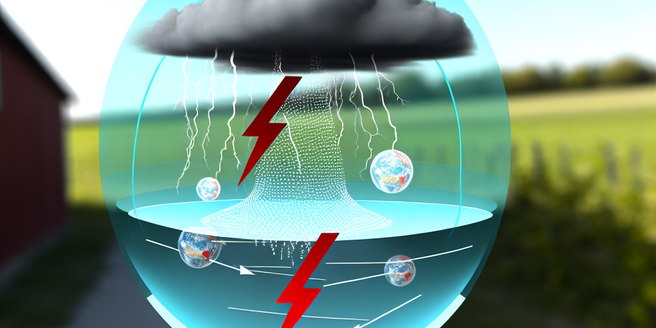
Understanding the Formation of Thunderstorms
Thunderstorms are a result of atmospheric disturbance along with heat and moisture. They require a specific set of conditions to develop, primarily an environment of unstable air that can rise rapidly. These specific conditions frequently occur during the warmer months when the sun’s rays are strongest. In some climates, this is particularly prevalent during the transition between spring and summer. Once these conditions are met, a thunderstorm can form quickly, often appearing in the late afternoon or early evening. When the surface of the Earth is heated by the sun, pockets of warm air, also known as ‘updrafts’, rise into the atmosphere. As the air rises and cools, it forms a cumulonimbus cloud, which is recognized as a storm cloud.
The Physics of Lightning: A Deep Dive
Lightning, a striking natural event, captivates our attention, resulting from an imbalance in electrical charge between Earth’s surface and a hovering thundercloud. This isn’t just superficial; underlying complexities are involved. The thundercloud exhibits an interesting clash of forces due to the segregation of electric charges within its components, a separation that arises from differing particle speeds and sizes in the turbulent air. Light, positively-charged particles usually ascend to the cloud’s top, while heavier, negatively-charged ones sink to the bottom, causing an accumulating electrical potential. Like a pressure cooker, this build-up eventually seeks a path for a major release. Upon exceeding a critical limit, the stored electricity discharges almost instantly, resulting in a brilliant flash we know as lightning. This demonstrates nature’s awesome, uncontrollable power and its mind-boggling complexities.
How Charge Separation Leads to Lightning Strikes
The intricacies of charge separation continue to be a fascinating domain of study. The commonly accepted theory posits that charge separation occurs due to repetitive, cyclical collisions within a thunderstorm, with ice particles playing an integral role. These tiny participants constantly collide and transfer charge, with the resulting positive or negative charge determining the physical properties of the particles. This leads to smaller, positively charged particles being swept towards the cloud’s top, while their larger, negatively charged counterparts descend to the cloud’s bottom. This location difference creates a vertical polarization within the cloud, setting up ideal conditions for a lightning discharge. Thus, charge separation is a fundamental process that prepares a storm cloud for a lightning bolt.
Connecting Thunder and Lightning: Cause and Effect
Lightning and thunder- these two natural phenomena always occur in combination and are deeply interconnected, usually observed during storms and truly showcasing nature’s immense power. A lightning bolt, carrying extreme heat, causes the adjacent air to expand rapidly, creating a shock wave that travels through air as thunder. However, due to the properties of light and sound, we perceive the events in a different sequence; because light travels faster than sound, we see the lightning almost instantaneously but hear the ensuing thunder after a delay. This differential travel time yields a fascinating spectacle where silent lightning precedes a thunderous roar, highlighting the wonder that is lightning and thunder.
The Impact of Thunderstorms on the Environment
Thunderstorms, often regarded as destructive due to their immense impact on the environment, bring about heavy rain which leads to soil erosion and flooding, disrupting habitats and the natural balance of the local biota. However, these storms also carry within them the seed for life, with their hallmark lightning feature contributing significantly to vital life processes. This lightning enables a chemical reaction that catalyzes the ‘fixing’ of nitrogen in the atmosphere. Not usually directly accessible by plants, nitrogen, abundant in the atmosphere, becomes usable with the help of this intense energy, and, accompanied by rain, soaks into the soil to nourish and promote plant growth. Thus, despite their potential harm, thunderstorms are pivotal in maintaining the balance of Earth’s environment, ensuring the flourishing of our planet’s life. This balance of creation and destruction, erosion and nourishment, marks thunderstorms as a fundamental ecological phenomenon.
